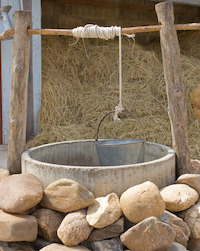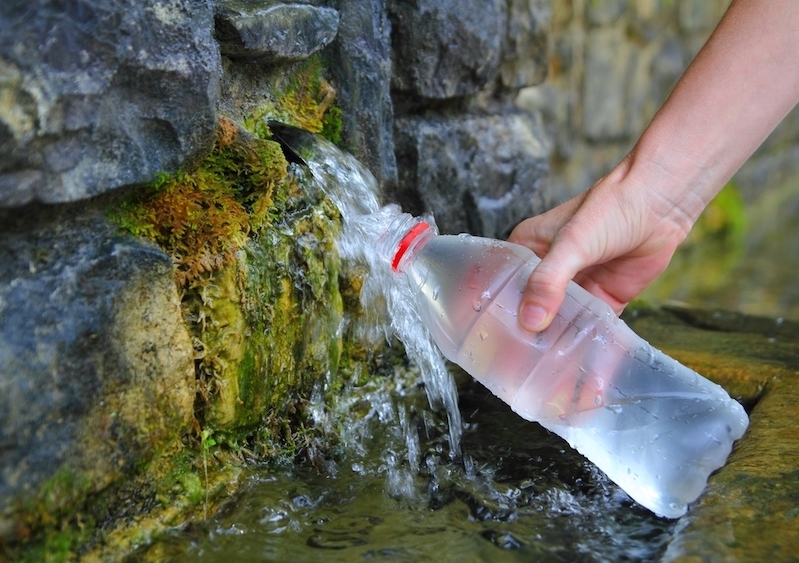
- Groundwater is the water that fills cracks and other openings in beds of rocks and sand.
- Each drop of rain that soaks into the soils moves downward to the water table, which is the water level in the groundwater reservoir. Groundwater does not normally occur in underground streams, lakes, or veins. Groundwater is found in soils and sands able to retain the water — much like a sponge holds water.
- Some 2.78 million trillion gallons of groundwater, 30.1 percent of the world’s fresh water, are estimated for the entire planet of Earth.1 Of the total 349 billion gallons of freshwater the United States withdraws each day, groundwater is estimated to be 79.6 billion gallons or 26 percent.2
- From 2010 to 2015, groundwater use in the United States increased by 8.3% while surface water use declined by 13.9%.3
- About a quarter of all U.S. rainfall becomes groundwater. Groundwater provides much of the flow of many streams; many lakes and streams are “windows” to the water table. In large part, the flow in a stream represents water that has flowed from the ground into the stream channel. It is estimated by the USGS that about 30 percent of U.S. stream-flow is from groundwater, although it is higher in some locations and less in others.4
- About 90 percent of our freshwater supplies lie underground, but less than 27 percent of the water Americans use comes from underground sources, which illustrates the under-utilization of groundwater.5
- Groundwater is a significant water supply source — the amount of groundwater storage dwarfs our present surface water supply.
- Hydrologists estimate, according to the National Geographic Society, U.S. groundwater reserves to be at least 33,000 trillion gallons — equal to the amount discharged into the Gulf of Mexico by the Mississippi River in the past 200 years.6
- At any given moment, groundwater is 20 to 30 times greater than the amount in all the lakes, streams, and rivers of the United States.7
- The United States uses 82.3 billion gallons per day of fresh groundwater for public supply, private supply, irrigation, livestock, manufacturing, mining, thermoelectric power, and other purposes.8
- California pumps 17.4 billion gallons per day of groundwater for all purposes, 2.4 times as much as the second-ranked state — Texas (7.2 bgd).9
- Groundwater is tapped through wells placed in water-bearing soils and rocks beneath the surface of the earth.
- More than 15.9 million water wells for all purposes serve the United States.10
- Approximately 500,000 new residential wells are constructed annually, according to NGWA estimates. The construction of these vitally needed water supply systems involves the use of more than 18,460 drilling machines by an estimated 8,085 groundwater contracting firms.11
- Groundwater is a renewable resource.
- In most parts of the country, water removed from the ground is constantly replaced, although in some parts of the country such as arid and semiarid regions, a low rate of replenishment is far exceeded by the rate of groundwater pumping, resulting in serious problems of groundwater mining.
- Adequate time is needed to allow replenishment of underlying groundwater reservoirs (aquifers); also such areas must be properly managed in order to prevent water-soluble waste products stored in these areas from infiltrating and polluting the underground supply.
- NGWA has determined that 38 percent of the U.S. population depends on groundwater for its drinking water supply — be it from either a public source or private well.12
- Private household wells constitute the largest share of all water wells in the United States — more than 13,135 million year-round occupied households have their own well.13
- Other kinds of wells are used for municipal systems, industry, agriculture, and quality monitoring. Groundwater accounts for 39 percent of all the water used by U.S. municipalities.14
- Michigan, with an estimated 1,121,075 households served by private water wells, is the largest state market, followed by Pennsylvania, North Carolina, New York, and Florida.15
- Irrigation accounts for the largest use of groundwater in the United States. Some 57.2 billion gallons of groundwater are used daily for agricultural irrigation from 475,796 wells.16 In 1900, the U.S. used only 2.2 billion gallons of groundwater daily for irrigation from 17,000 wells.
- More than 90 percent of the groundwater pumped from the Ogallala, the nation’s largest aquifer underlying some 250,000 square miles stretching from Texas to South Dakota, is used for agricultural irrigation. Representing about one-third of all U.S. irrigated agriculture, it creates about $20 billion annually in food and fiber.
- If spread across the surface of the entire United States, the Ogallala’s groundwater would cover all 50 states with 1.5 feet of water. Scientists estimate it could take 6,000 years to refill naturally if it were ever to be fully withdrawn.17

- Texas leads the nation in the number of irrigation wells with 81,511.18
- The following myths continue to be perpetuated about groundwater:
- Groundwater moves rapidly.
- Groundwater migrates thousands of miles.
- There is no relationship between groundwater and surface water.
- Groundwater removed from the earth is never returned.
- Groundwater is mysterious and occult.
- Groundwater is not a significant source of water supply.
